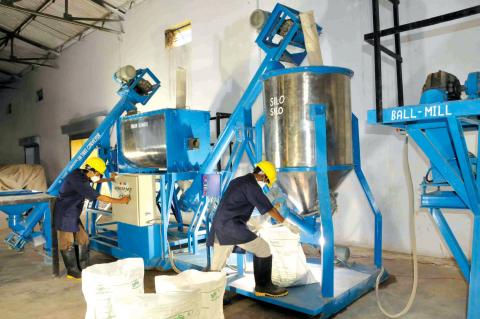5. MINERAL MIXTURE PRODUCTION PROCESS
Dairy cattle and buffaloes require a number of dietary mineral elements for normal body maintenance, growth and reproduction. Minerals that are required in relatively large amounts are called major or macro elements. Those needed in small amounts are classified as micro, minor or trace minerals. The major minerals include calcium, phosphorus, magnesium, potassium, sodium, chlorine and sulphur. Among those needed in trace amounts are iron, zinc, manganese, copper, iodine, cobalt and selenium. Deficiency of minerals in the ration o animals impairs metabolic functions, which affects the growth in young calves and milk production and reproduction efficiency in adult animals. Supplementation of bio-available minerals through mineral mixture is of paramount importance, as minerals are nowhere synthesized in animal’s body.
Mineral mixture plants in different parts of the country produce mineral mixture using a ribbon mixer, in which all macro and micro mineral salts are dumped, without prior grinding. Mineral mixture contains mineral salts as high as 66 per cent and as low as 0.06 per cent. If all the mineral salts are dumped as such without prior grinding and mixing using proper diluents then the stability and uniform mixing is a problem. As a result, animals don’t get various minerals in a desired proportion, when such mineral mixtures are supplemented in the ration of animals. Moreover, existing mineral mixture plants don’t use mineral salts which are in dried or as monohydrates. These salts when mixed in a particular proportion and stored for further use, lead to lump formation.

Fig. 5.1 Mineral mixture manufacturing plant
Therefore, a mineral mixture plant (Fig. 5.1) has been designed in which dried/monohydrate salts are crushed and mixed to a uniform particle size, using proper diluents, in a separate device, called ball mill. This is called pre-mix, which is taken in the ribbon mixer, along with other macro mineral salts for uniform mixing and distribution. The resultant mineral mixture thus produced is a free flowing powder, which contains all mineral salts in desired proportion and stable form.
